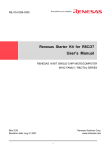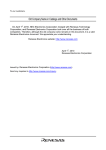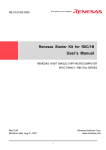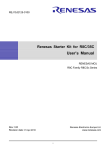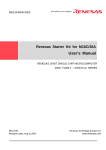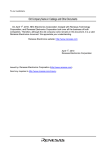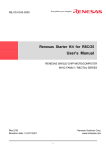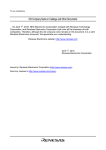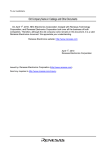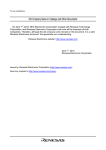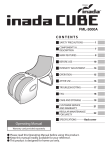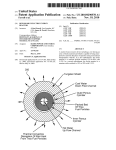Download Renesas Starter Kit for R8C/27 User`s Manual
Transcript
To our customers, Old Company Name in Catalogs and Other Documents On April 1st, 2010, NEC Electronics Corporation merged with Renesas Technology Corporation, and Renesas Electronics Corporation took over all the business of both companies. Therefore, although the old company name remains in this document, it is a valid Renesas Electronics document. We appreciate your understanding. Renesas Electronics website: http://www.renesas.com April 1st, 2010 Renesas Electronics Corporation Issued by: Renesas Electronics Corporation (http://www.renesas.com) Send any inquiries to http://www.renesas.com/inquiry. Notice 1. 2. 3. 4. 5. 6. 7. All information included in this document is current as of the date this document is issued. Such information, however, is subject to change without any prior notice. Before purchasing or using any Renesas Electronics products listed herein, please confirm the latest product information with a Renesas Electronics sales office. Also, please pay regular and careful attention to additional and different information to be disclosed by Renesas Electronics such as that disclosed through our website. Renesas Electronics does not assume any liability for infringement of patents, copyrights, or other intellectual property rights of third parties by or arising from the use of Renesas Electronics products or technical information described in this document. No license, express, implied or otherwise, is granted hereby under any patents, copyrights or other intellectual property rights of Renesas Electronics or others. You should not alter, modify, copy, or otherwise misappropriate any Renesas Electronics product, whether in whole or in part. Descriptions of circuits, software and other related information in this document are provided only to illustrate the operation of semiconductor products and application examples. You are fully responsible for the incorporation of these circuits, software, and information in the design of your equipment. Renesas Electronics assumes no responsibility for any losses incurred by you or third parties arising from the use of these circuits, software, or information. When exporting the products or technology described in this document, you should comply with the applicable export control laws and regulations and follow the procedures required by such laws and regulations. You should not use Renesas Electronics products or the technology described in this document for any purpose relating to military applications or use by the military, including but not limited to the development of weapons of mass destruction. Renesas Electronics products and technology may not be used for or incorporated into any products or systems whose manufacture, use, or sale is prohibited under any applicable domestic or foreign laws or regulations. Renesas Electronics has used reasonable care in preparing the information included in this document, but Renesas Electronics does not warrant that such information is error free. Renesas Electronics assumes no liability whatsoever for any damages incurred by you resulting from errors in or omissions from the information included herein. Renesas Electronics products are classified according to the following three quality grades: “Standard”, “High Quality”, and “Specific”. The recommended applications for each Renesas Electronics product depends on the product’s quality grade, as indicated below. You must check the quality grade of each Renesas Electronics product before using it in a particular application. You may not use any Renesas Electronics product for any application categorized as “Specific” without the prior written consent of Renesas Electronics. Further, you may not use any Renesas Electronics product for any application for which it is not intended without the prior written consent of Renesas Electronics. Renesas Electronics shall not be in any way liable for any damages or losses incurred by you or third parties arising from the use of any Renesas Electronics product for an application categorized as “Specific” or for which the product is not intended where you have failed to obtain the prior written consent of Renesas Electronics. The quality grade of each Renesas Electronics product is “Standard” unless otherwise expressly specified in a Renesas Electronics data sheets or data books, etc. “Standard”: 8. 9. 10. 11. 12. Computers; office equipment; communications equipment; test and measurement equipment; audio and visual equipment; home electronic appliances; machine tools; personal electronic equipment; and industrial robots. “High Quality”: Transportation equipment (automobiles, trains, ships, etc.); traffic control systems; anti-disaster systems; anticrime systems; safety equipment; and medical equipment not specifically designed for life support. “Specific”: Aircraft; aerospace equipment; submersible repeaters; nuclear reactor control systems; medical equipment or systems for life support (e.g. artificial life support devices or systems), surgical implantations, or healthcare intervention (e.g. excision, etc.), and any other applications or purposes that pose a direct threat to human life. You should use the Renesas Electronics products described in this document within the range specified by Renesas Electronics, especially with respect to the maximum rating, operating supply voltage range, movement power voltage range, heat radiation characteristics, installation and other product characteristics. Renesas Electronics shall have no liability for malfunctions or damages arising out of the use of Renesas Electronics products beyond such specified ranges. Although Renesas Electronics endeavors to improve the quality and reliability of its products, semiconductor products have specific characteristics such as the occurrence of failure at a certain rate and malfunctions under certain use conditions. Further, Renesas Electronics products are not subject to radiation resistance design. Please be sure to implement safety measures to guard them against the possibility of physical injury, and injury or damage caused by fire in the event of the failure of a Renesas Electronics product, such as safety design for hardware and software including but not limited to redundancy, fire control and malfunction prevention, appropriate treatment for aging degradation or any other appropriate measures. Because the evaluation of microcomputer software alone is very difficult, please evaluate the safety of the final products or system manufactured by you. Please contact a Renesas Electronics sales office for details as to environmental matters such as the environmental compatibility of each Renesas Electronics product. Please use Renesas Electronics products in compliance with all applicable laws and regulations that regulate the inclusion or use of controlled substances, including without limitation, the EU RoHS Directive. Renesas Electronics assumes no liability for damages or losses occurring as a result of your noncompliance with applicable laws and regulations. This document may not be reproduced or duplicated, in any form, in whole or in part, without prior written consent of Renesas Electronics. Please contact a Renesas Electronics sales office if you have any questions regarding the information contained in this document or Renesas Electronics products, or if you have any other inquiries. (Note 1) “Renesas Electronics” as used in this document means Renesas Electronics Corporation and also includes its majorityowned subsidiaries. (Note 2) “Renesas Electronics product(s)” means any product developed or manufactured by or for Renesas Electronics. User’s Manual Renesas Starter Kit for R8C/27 User’s Manual RENESAS 16-BIT SINGLE-CHIP MICROCOMPUTER M16C FAMILY / R8C/Tiny SERIES Rev.3.00 2007.08 Table of Contents Chapter 1. Preface .................................................................................................................................................. 1 Chapter 2. Purpose ................................................................................................................................................. 2 Chapter 3. Power Supply ........................................................................................................................................ 3 3.1. Requirements ............................................................................................................................................... 3 3.2. Power – Up Behaviour ................................................................................................................................. 3 Chapter 4. Board Layout ......................................................................................................................................... 4 4.1. Component Layout ....................................................................................................................................... 4 4.2. Board Dimensions ........................................................................................................................................ 5 Chapter 5. Block Diagram ....................................................................................................................................... 6 Chapter 6. User Circuitry......................................................................................................................................... 7 6.1. Switches ....................................................................................................................................................... 7 6.2. LEDs ............................................................................................................................................................. 7 6.3. Potentiometer ............................................................................................................................................... 7 6.4. Serial port ..................................................................................................................................................... 8 6.5. LCD Module.................................................................................................................................................. 8 6.6. Option Links.................................................................................................................................................. 9 6.7. Oscillator Sources ...................................................................................................................................... 13 6.8. Reset Circuit ............................................................................................................................................... 13 6.9. LIN Interface ............................................................................................................................................... 13 Chapter 7. Modes.................................................................................................................................................. 14 7.1. Boot mode .................................................................................................................................................. 14 7.2. Single chip mode ........................................................................................................................................ 14 Chapter 8. Programming Methods........................................................................................................................ 15 Chapter 9. Headers............................................................................................................................................... 16 9.1. Microcontroller Headers ............................................................................................................................. 16 9.2. Application Headers ................................................................................................................................... 17 Chapter 10. Code Development ........................................................................................................................... 19 10.1. Overview................................................................................................................................................... 19 10.2. Mode Support ........................................................................................................................................... 19 10.3. Breakpoint Support................................................................................................................................... 19 10.4. Memory Map............................................................................................................................................. 20 Chapter 11. Component Placement...................................................................................................................... 21 Chapter 12. Additional Information ....................................................................................................................... 22 ii Chapter 1. Preface Cautions This document may be, wholly or partially, subject to change without notice. All rights reserved. Duplication of this document, either in whole or part is prohibited without the written permission of Renesas Solutions Corporation. Trademarks All brand or product names used in this manual are trademarks or registered trademarks of their respective companies or organisations. Copyright © Renesas Solutions Corp. 2007. All rights reserved. © Renesas Technology Europe Ltd. 2007. All rights reserved. © Renesas Technology Corp. 2007. All rights reserved. Website: http://www.eu.renesas.com/ (Europe) http://www.renesas.com/ (Global) Glossary ADC Analog Digital Converter LCD Liquid Crystal Display CPU Central Processing Unit LED Light Emitting Diode DAC Digital Analog Converter LIN Local Interconnect Network E8a E8a On-chip debugger module LSI Large Scale Integration IRQ Interrupt ReQuest 1 Chapter 2. Purpose This Renesas Starter Kit is an evaluation tool for Renesas microcontrollers. Features include: • Renesas Microcontroller Programming. • User Code Debugging. • User Circuitry such as Switches, LEDs and potentiometer(s). • User or Example Application. • Sample peripheral device initialisation code. The Renesas Starter Kit board contains all the circuitry required for microcontroller operation. NOTE: This manual describes the technical details of the Renesas Starter Kit for R8C/27 hardware. The Quick Start Guide and Tutorial Manual provide details of the software installation and debugging environment. 2 Chapter 3. Power Supply 3.1. Requirements This Renesas Starter Kit operates from a 3V to 5V power supply. A diode provides reverse polarity protection only if a current limiting power supply is used. All Renesas Starter Kit boards are supplied with an E8a debugger. This product is able to power the Renesas Starter Kit board with up to 300mA. When the Renesas Starter Kit is connected to another system then that system should supply power to the Renesas Starter Kit. All Renesas Starter Kit boards have an optional centre positive supply connector using a 2.1mm barrel power jack. Warning The Renesas Starter Kit is neither under nor over voltage protected. Use a centre positive supply for this board. 3.2. Power – Up Behaviour When the Renesas Starter Kit is purchased the Renesas Starter Kit board has the ‘Release’ or stand alone code from the example tutorial code pre-programmed into the Renesas microcontroller. On powering up the board the user LEDs will start to flash. After 200 flashes, or after pressing a switch the LEDs will flash at a rate controlled by the potentiometer. 3 Chapter 4. Board Layout 4.1. Component Layout The following diagram shows the top layer component layout of the board. Figure 4-1: Board Layout 4 4.2. Board Dimensions The following diagram gives the board dimensions and connector positions. All through hole connectors are on a common 0.1” grid for easy interfacing. Figure 4-2 : Board Dimensions 5 Chapter 5. Block Diagram Figure 5-1 is representative of the CPU board components and their connectivity. Figure 5-1: Block Diagram Figure 5-2 is representative of the connections required to the Renesas Starter Kit. USB Cable Personal Computer E8a emulator User Interface Cable Pin 1 MCU CPU Board Figure 5-2 : Renesas Starter Kit Connections 6 Chapter 6. User Circuitry 6.1. Switches There are four switches located on the board. The function of each switch and its connection are shown in Table 6-1. Switch Function Microcontroller RES When pressed, the board microcontroller is reset. RESET Pin3 SW1/BOOT* Connects to an IRQ input for user controls. INT1 Pin10 The switch is also used in conjunction with the RES switch to place (Port 1, pin 7) the device in BOOT mode when not using the E8a debugger. SW2* Connects to an IRQ Interrupt input for user controls. INT3 Pin23 (Port 3, pin 3) SW3* Connects to a Key In Interrupt input for user controls KI0 Pin22 (Port 1, pin 0) Table 6-1: Switch Functions *Refer to schematic for detailed connectivity information. 6.2. LEDs There are six LEDs on the CPU board. The green ‘POWER’ LED lights when the board is powered. The orange ‘BOOT’ LED indicates the device is in BOOT mode when lit. The four user LEDs are connected to an IO port and will light when their corresponding port pin is set low. Table 6-2, below, shows the LED pin references and their corresponding microcontroller port pin connections. LED Reference Colour (As shown on silkscreen) Microcontroller Port Microcontroller Pin Number Pin function LED0 Green Port 0.0 32 LED1 Orange Port 0.1 31 LED2 Red Port 0.2 30 LED3 Red Port 0.3 29 Table 6-2: LED Port 6.3. Potentiometer A single turn potentiometer is connected to AN11 (P1.3) of the microcontroller. This may be used to vary the input analog voltage value to this pin between VREF and Ground. 7 6.4. Serial port The microcontroller programming serial port 1 is connected to the RS232 transceiver. This serial port can optionally be connected to the RS232 transceiver as well by fitting option resistors. The connections to be fitted are listed in the Table 6-3. Description Function Fit for RS232 TxD1 Programming Serial Port R43 RxD1 Programming Serial Port R44 Table 6-3: Serial Port settings A Secondary serial port is connected to the application headers. This is shared with the LIN module. 6.5. LCD Module A LCD module is supplied to be connected to the connector J8. This should be fitted so that the LCD module lies over J1. Care should be taken to ensure the pins are inserted correctly into J8.The LCD module uses a 4 bit interface to reduce the pin allocation. No contrast control is provided; this is set by a resistor on the supplied display module. The module supplied with the Renesas Starter Kit only supports 5V operation. Table 6-4 shows the pin allocation and signal names used on this connector. J8 Pin Circuit Net Name Device Pin Circuit Net Name Device Pin Pin 1 Ground - 2 5V Only - 3 No Connection - 4 LCD_RS 14 5 R/W (Wired to Write only) - 6 LCD_E 13 7 No Connection - 8 No Connection - 9 No Connection - 10 No Connection - 11 LCD_D4 28 12 LCD_D5 27 13 LCD_D6 26 14 LCD_D7 25 Table 6-4: LCD Module Connections 8 6.6. Option Links Table 6-5 below describes the function of the option links associated with Power configuration. The default configuration is indicated by BOLD text. Option Link Settings Reference R16 Function Power Supply Fitted Alternative (Removed) Connects J5 to Board_VCC J5 disconnected from Related To R18 Board_VCC R18 R19 R20 R21 Power Supply Connects Board_VCC to Board_VCC disconnected from R16, R17, R19, board voltage line board voltage line R20, R21 Power Supply Connects CON_5V (external CON_5V disconnected from R18, R20, R21 (External 5V) 5V) to Board_VCC Board_VCC Power Supply Connects CON_3V3 (external CON_3V3 disconnected from (External 3.3V) 3.3V) to Board_VCC Board_VCC MCU Power Supply Supply to MCU Fit Low ohm resister to R18, R19, R21 R18, R19, R20 measure current R28 User I/O Power Supply Connects Board_VCC to Board_VCC disconnected from SW2, 3 and LED0-3 SW2, 3 and LED0-3 Table 6-5: Power Configuration Links Table 6-6 below describes the function of the option links associated with Clock configuration. The default configuration is indicated by BOLD text. Option Link Settings Reference R8 Function Oscillator Fitted Connects external clock to Alternative (Removed) Related To Connects X1 or X2 to MCU R10, R11, R12, MCU R10 Oscillator R13, R14 Connects external clock to Connects X1 or X2 to MCU MCU R11 Oscillator R14 Connects X2 to MCU (Sub clock) R12 Oscillator Connects X2 to MCU (Sub clock) R13 Oscillator Connects X1 to MCU (Main clock) R14 Oscillator Connects X1 to MCU (Main clock) R15 R8, R11, R12, R13, Oscillator Parallel resistor for sub clock (Sub clock) (X2) Connects X1 or external R8, R10, R12, R13, clock to MCU R14, R15 Connects X1 or external R8, R10, R11, R13, clock to MCU R14, R15 Connects X2 or external clock R8, R10, R11, R12, to MCU R14 Connects X2 or external clock R8, R10, R11, R12, to MCU R13 Not fitted R11, R12 Table 6-6: Clock Configuration Links 9 Table 6-7 below describes the function of the option links associated with Serial configuration. The default configuration is indicated by BOLD text. Option Link Settings Reference R42 R43 R44 Function RS232 Serial Fitted Alternative (Removed) Disables RS232 Serial Enables RS232 Serial Transceiver Transceiver Programming Connects RS232 port to Disconnected Serial Port Programming serial port Programming Connects RS232 port to Serial Port Programming serial port Related To R43, R44 Disconnected Table 6-7: Serial Configuration Links Table 6-8 below describes the function of the option links associated with LIN configuration. The default configuration is indicated by BOLD text. Option Link Settings Reference Function Fitted Alternative (Removed) Related To R63 LIN For Master node setting For Slave node setting R64, R65, R66 R64 LIN Connects LIN-NSLP to MCU Disconnected R63, R65, R66 Disconnected R63, R64, R66 Disconnected R63, R64, R65 port P1_6 R65 LIN Connects LIN-RXD0 to MCU port P1_5 R66 LIN Connects LIN-TXD0 to MCU port P1_4 Table 6-8: LIN Configuration Links Table 6-9 below describes the function of the option links associated with Analog configuration. The default configuration is indicated by BOLD text. Option Link Settings Reference R6 R17 Function ADC ADC Fitted Alternative (Removed) Connects CON_VREF CON_VREF disconnected from (Reference voltage) to MCU MCU Connects CON_VREF to CON_VREF disconnected from Board_VCC Board_VCC Table 6-9: Analog Configuration Links 10 Related To R17 R6 Table 6-10 below describes the function of the option links associated with microcontroller pin function select configuration. The default configuration is indicated by BOLD text. Option Link Settings Reference R46 R47 R48 R49 R50 R53 R55 R56 R57 R58 R59 R60 Function Fitted Alternative (Removed) MCU Pin Function Connects AD3 to MCU port Select P0_4 MCU Pin Function Connects IO_4 to MCU port Select P0_4 MCU Pin Function Connects AD2 to MCU port Select P0_5 MCU Pin Function Connects IO_5 to MCU port Select P0_5 MCU Pin Function Connects IRQ1 to MCU port Select P1_7 MCU Pin Function Connects TRIGb to MCU port Select P1_7 MCU Pin Function Connects AD1 to MCU port Select P0_6 MCU Pin Function Connects IO_6 to MCU port Select P0_6 MCU Pin Function Connects AD0 to MCU port Select P0_7 MCU Pin Function Connects IO_7 to MCU port Select P0_7 MCU Pin Function Connects IRQ0 to MCU port Select P4_5 MCU Pin Function Connects TRIGa to MCU port Select P4_5 Disconnected R47 Disconnected R46 Disconnected R49 Disconnected R48 Disconnected R29, R53 Disconnected R29, R50 Disconnected R56 Disconnected R55 Disconnected R58 Disconnected R57 Disconnected R60 Disconnected R59 Table 6-10: MCU Pin Function Select Configuration Links 11 Related To Table 6-11 below describes the function of the option links associated with other options. The default configuration is indicated by BOLD text. Option Link Settings Reference R29 Function SW1 Fitted Alternative (Removed) Connects SW1 to MCU port Disconnected P4_5 R45 E8a Enables E8a Connection Do not fit the option resistor R54 LCD Module Connects LCD_E to MCU port Disconnected P5_4 Table 6-11: Other Option Links 12 Related To R50, R53 6.7.Oscillator Sources Crystal oscillators are fitted on the board and used to supply the main/sub clock input to the Renesas microcontroller. Table 6-12: Oscillator details the oscillators that are fitted and alternative footprints provided on this board: Component Main clock (X1) Fitted 20 MHz (HC/49U package) Sub clock (X2) Fitted 32.768 kHz (90SMX package) Table 6-12: Oscillator Main clock ‘X1’ is connected to microcontroller via the option resistors by the default. 6.8. Reset Circuit The CPU Board includes a simple latch circuit that links the mode selection and reset circuit. This provides an easy method for swapping the device between Boot mode and Single chip mode. This circuit is not required on customers’ boards as it is intended for providing easy evaluation of the operating modes of the device on the Renesas Starter Kit. Please refer to the hardware manual for more information on the requirements of the reset circuit. The Reset circuit operates by latching the state of the boot switch on pressing the reset button. This control is subsequently used to modify the MODE pin states as required. The MODE pin should change state only while the reset signal is active to avoid possible device damage. The reset is held in the active state for a fixed period by a pair of resistors and a capacitor. Please check the reset requirements carefully to ensure the reset circuit on the customers’ board meets all the reset timing requirements. 6.9. LIN Interface This Renesas Starter Kit has hardware LIN interface. The interface is available on connector ‘J10’. The connector ‘J9’ functions as power connector for LIN. The device can be operated either in Master node or Slave node. The device performs LIN communication in cooperation with Timer RA and UART0. For more details on LIN interface please refer to R8C/26 Group, R8C/27 Group Hardware Manual. 13 Chapter 7. Modes The Renesas Starter Kit supports Boot mode and Single chip mode. Details of programming the FLASH memory is described in the R8C/26 Group, R8C/27 Group Hardware Manual. 7.1. Boot mode The Boot mode settings for this Renesas Starter Kit are shown in Table 7-1: Boot Mode pin settings below: MODE LSI State after Reset End Low Boot Mode Table 7-1: Boot Mode pin settings The software supplied with this Renesas Starter Kit supports Boot mode using an E8a and High-performance Embedded Workshop only. However, hardware exists to enter boot mode manually, do not connect the E8a in this case. Press and hold the SW1/BOOT. The mode pin is held in its boot state while reset is pressed and released. Release the boot button. The BOOT LED will be illuminated to indicate that the microcontroller is in boot mode. When neither the E8a is connected nor the board is placed in boot mode as above, the MODE pin is pulled high by a 4.7k resistor. When an E8a is used the MODE pin is controlled by the E8a. 7.2. Single chip mode Because the MODE pin is pulled high, this Renesas Starter Kit will always boot in Single chip mode when the E8a is not connected and the boot switch is not depressed. Refer to R8C/26 Group, R8C/27 Group Hardware Manual for details of Single chip mode. MODE LSI State after Reset End High Single chip Mode Table 7-2: Single chip Mode pin settings 14 Chapter 8. Programming Methods The board is intended for use with High-performance Embedded Workshop and the supplied E8a debugger. Refer to R8C/26 Group, R8C/27 Group Hardware Manual for details of programming the microcontroller without using these tools. 15 Chapter 9. Headers 9.1. Microcontroller Headers Table 9-1 to Table 9-4 show the microcontroller pin headers and their corresponding microcontroller connections. The header pins connect directly to the microcontroller pins. * Marked pins are subject to option links. J1 Pin Circuit Net Name Device Pin Pin Circuit Net Name Device Pin 1 IIC_SCL 1 2 TMR1 2 3 RESn 3 4 CON_XOUT 4 5 Ground (VSS) 5 6 CON_XIN 6 7 UC_VCC 7 8 MODE_E8B 8 Table 9-1: J1 J2 Pin Circuit Net Name Device Pin Pin Circuit Net Name Device Pin 1 IRQ0/TRIGa* 9 2 IRQ1/TRIGb* 10 3 TRISTn 11 4 MO_UD 12 5 MO_Wp 13 6 MO_Vp 14 7 SCIaCK 15 8 SCIaRX 16 Table 9-2: J2 J3 Pin Circuit Net Name Device Pin Pin Circuit Net Name Device Pin 1 SCIaTX 17 2 AD_POT 18 3 MO_Up 19 4 P4_2/VREF 20 5 TMR0 21 6 IRQ3 22 7 IRQ2 23 8 IIC_SDA 24 Table 9-3: J3 J4 Pin Circuit Net Name Device Pin Pin Circuit Net Name Device Pin 1 AD0/IO_7* 25 2 AD1/IO_6* 26 3 AD2/IO_5* 27 4 AD3/IO_4* 28 5 IO_3 29 6 IO_2 30 7 IO_1 31 8 IO_0 32 Table 9-4: J4 16 9.2. Application Headers Table 9-5 and Table 9-6 below show the standard application header connections. * Marked pins are subject to option links. JA1 Pin Header Name Circuit Net Device Name Pin Pin Header Name Circuit Net Device Name Pin 1 Regulated Supply 1 CON_5V - 2 Regulated Supply 1 Ground - 3 Regulated Supply 2 CON_3V3 - 4 Regulated Supply 2 Ground - 5 Analogue Supply NC - 6 Analogue Supply NC - 7 Analogue Reference CON_VREF 20 8 ADTRG NC - 9 ADC0 AD0* 25 10 ADC1 AD1* 26 11 ADC2 AD2* 27 12 ADC3 AD3* 28 13 DAC0 NC - 14 DAC1 NC - 15 IOPort0 IO_0 32 16 IOPort1 IO_1 31 17 IOPort2 IO_2 30 18 IOPort3 IO_3 29 19 IOPort4 IO_4* 28 20 IOPort5 IO_5* 27 21 IOPort6 IO_6* 26 22 IOPort7 IO_7* 25 23 IRQ3 IRQ3 22 24 I2C Bus (3rd pin) NC - 25 I²C Bus IIC_SDA 24 26 I²C Bus IIC_SCL 1 Table 9-5: JA1 Standard Generic Header JA2 Pin Header Name Circuit Net Device Name Pin Pin Header Name Circuit Net Device Name Pin 1 Reset RESn 3 2 External Clock Input CON_XIN 6 3 Interrupt NC - 4 Regulated Supply 1 Ground - 5 WDT overflow NC - 6 Serial Port SCIaTX 17 7 Interrupt IRQ0* 9 8 Serial Port SCIaRX 16 9 Interrupt IRQ1* 10 10 Serial Port SCIaCK 15 11 Motor up/down MO_UD 12 12 Serial Port Handshake NC - 13 Motor control MO_Up 19 14 Motor control NC - 15 Motor control MO_Vp 14 16 Motor control NC - 17 Motor control MO_Wp 13 18 Motor control NC - 19 Timer Output TMR0 21 20 Timer Output TMR1 2 21 Timer Input TRIGa* 9 22 Timer Input TRIGb* 10 23 Interrupt IRQ2 23 24 Tristate Control TRISTn 11 25 SPARE CON_XOUT 4 26 SPARE AD_POT 18 Table 9-6: JA2 Standard Generic Header 17 Table 9-7 below show the LIN header connections. J9 Pin Function Signal Name 1 Power Supply (for LIN module) VBAT 2 Ground Ground J10 Pin Function Signal Name 1 Power Supply (for LIN module) VBAT 2 LIN Bus Line LIN 3 Ground Ground Table 9-7: LIN Headers 18 Chapter 10.Code Development 10.1. Overview Note: For all code debugging using Renesas software tools, the Renesas Starter Kit board must be connected to a Personal Computer USB port via an E8a. An E8a is supplied with the Renesas Starter Kit product. 10.2. Mode Support High-performance Embedded Workspace connects to the Microcontroller and programs it via the E8a. Mode support is handled transparently to the user. 10.3. Breakpoint Support High-performance Embedded Workshop supports breakpoints on the user code, both in RAM and ROM. Double clicking in the breakpoint column in the code sets the breakpoint. Breakpoints will remain unless they are double clicked to remove them. 19 10.4. Memory Map Figure 10-1 : Memory Map 20 Chapter 11. Component Placement Figure 11-1 : Component Placement 21 Chapter 12. Additional Information For details on how to use High-performance Embedded Workshop, refer to the High-performance Embedded Workshop manual available on the CD or from the web site. For information about the R8C/27 group microcontrollers, refer to the R8C/26 Group, R8C/27 Group Hardware Manual. For information about the R8C/27 assembly language, refer to the R8C/Tiny Series Software Programming Manual. Online technical support and information is available at: http://www.renesas.com/renesas_starter_kits Technical Contact Details America: [email protected] Europe: [email protected] Japan: [email protected] General information on Renesas Microcontrollers can be found on the Renesas website at: http://www.renesas.com/. 22 Renesas Starter Kit for R8C/27 User's Manual Publication Date Rev.3.00 Aug.31,2007 Published by: Renesas Solutions Corp. 4-1-6, Miyahara, Yodogawa-ku, Osaka City, 532-0003, Japan ©2007 Renesas Solutions Corp., Renesas Technology Europe Ltd. and Renesas Technology Corp., All Rights Reserved. Renesas Starter Kit for R8C/27 User’s Manual 1753, Shimonumabe, Nakahara-ku, Kawasaki-shi, Kanagawa 211-8668 Japan REJ10J1288-0300




























